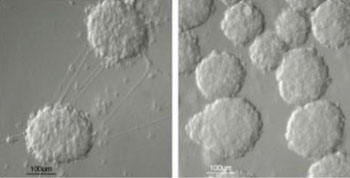Stem Cell Therapy Cures Diabetes in Mouse Model
By LabMedica International staff writers
Posted on 09 Feb 2015
Diabetes researchers modified human skin cells to produce insulin and showed that after being injected into diabetic immunodeficient mice, the cells developed into an insulin-producing organoid capable of modulating the animals' glucose metabolism.Posted on 09 Feb 2015
In type I diabetes, the individual's immune system attacks and destroys the pancreatic beta cells that produce insulin. While pancreas transplants from cadavers can be used to treat the disorder, the very small number of available organs limits usefulness of this method.

Image: Researchers reprogrammed human skin cells to create induced pluripotent stem cells, which were then differentiated in a stepwise fashion to create insulin-producing cells. When these cells were transplanted into diabetic mice, the cells secreted insulin and reduced the blood sugar levels of the mice to normal or near-normal levels. The micrograph shows the insulin-producing cells (right) and precursor cells (left) (Photo courtesy of the University of Iowa).
In a different approach, investigators at the University of Iowa (Iowa City, USA) modified human skin cells to create induced pluripotent stem (iPS) cells. The undifferentiated iPS cells were subjected to differentiation using a multistep protocol to generate insulin producing cells (IPCs) in vitro. The successful differentiation of human iPS cells into IPCs was validated by real-time quantitative PCR, immunostaining, transmission electron microscopy, and mitochondria stress tests.
The IPCs were injected into streptozotocin-induced diabetic immunodeficient mice under the kidney capsule, a thin membrane layer that surrounds the kidney. The real-time fate of the transplanted IPCs was monitored by MRI, which revealed the presence of an organoid on the kidneys of the mice that received IPCs. These organoids showed neo-vascularization and stained positive for insulin and glucagon. The animals' serum glucose levels gradually declined to either normal or near normal levels over 150 days, suggesting that the IPCs were secreting insulin. Furthermore, none of the mice that had received IPCs developed tumors from the transplanted stem cells.
"This raises the possibility that we could treat patients with diabetes with their own cells," said senior author Dr. Nicholas Zavazava, professor of internal medicine at the University of Iowa. "That would be a major advance, which will accelerate treatment of diabetes."
The study was published in the January 28, 2015, online edition of the journal PLOS ONE.
Related Links:
University of Iowa













